When it comes to procurement, there’s no shortage of important terms and acronyms. And, there’s one that consistently causes considerable confusion: RFX. Indeed, ‘RFX meaning’ and ‘What is an RFX?’ are common searches for those learning about procurement.
This blog will explore the term and offer the meaning of RFX. Then, we’ll provide an overview of the types of procurement documents included in the RFX definition. Next, we’ll share a step-by-step guide to the basic RFX process. And, finally, we’ll list resources you can explore to learn more.
RFX meaning
So, what is an RFX? What does RFX actually mean? In procurement, the acronym RFX means request for X, where X is a variable that stands in for different types of vendor questionnaires. For example, RFX could stand for request for proposal (RFP), request for quotation (RFQ), request for information (RFI) and so on.
The term is commonly used in procurement and request management when discussing sourcing processes that may require more than one type of RFX. It may be used as a placeholder when a specific type of information request has not yet been selected. For instance, if you know you need to make an IT software purchase, but you’re not yet sure if you need to use an RFI vs RFP vs RFQ. Additionally you may also encounter it when searching for strategic sourcing solutions. While a lot of sourcing technology is classified as RFP specific, any RFP software tool can easily be used for every kind of question and answer document.
For additional RFX definitions, explore this glossary of terms.
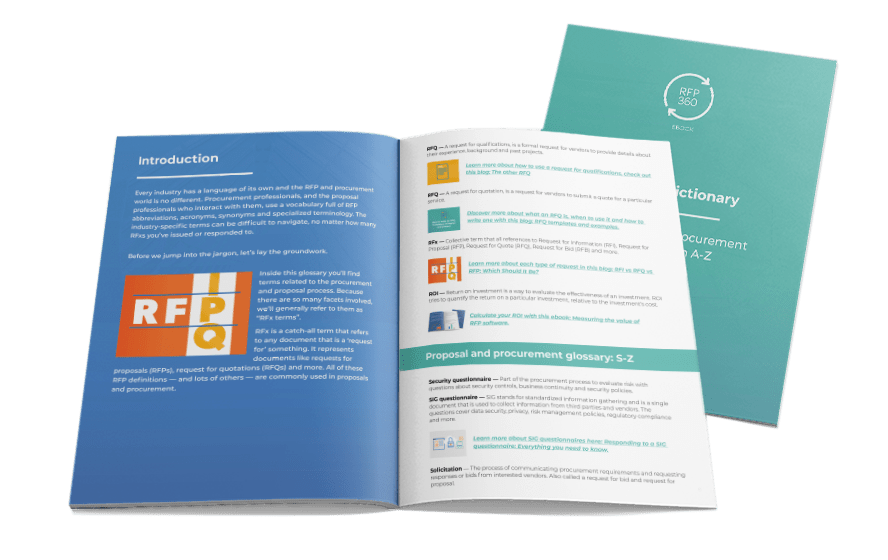
10 kinds of RFX documents
There are a lot of different vendor questionnaires that fall into the definition of an RFX. As you may expect, some are very well known and commonly used while others are specific to a particular industry or region.
Here you’ll find an overview and key information about every type of RFX. We’ll start with the most commonly searched RFX meanings and move down the list into more obscure RFX types.
Request for proposal — RFP
Definition: RFP, meaning request for proposal, is a formal, standardized questionnaire issued to prospective vendors to compare them and select the best option. In addition to RFP questions, the document contains information about the project challenges, goals and scope.
Use case: An RFP indicates that an organization is ready to make a purchase. Typically, it requests general information and also asks a combination of complex and closed-ended questions. Thanks to their detail, RFPs are a good fit for high-value strategic sourcing projects.
Helpful resources:
- A guide to the meaning of request for proposal (RFP)
- Downloadable RFP template in Word
- RFP process guide ebook: Basics, steps and stakeholders
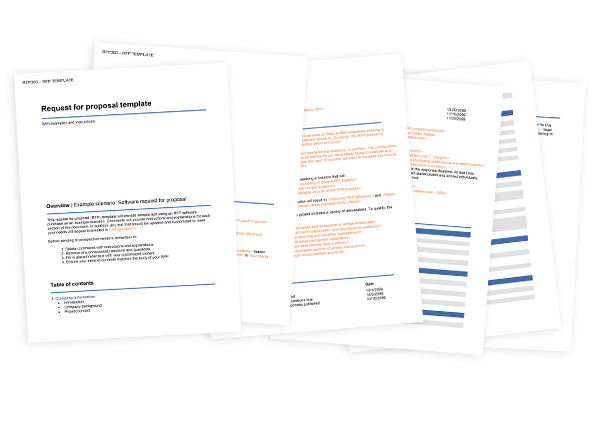
Request for information — RFI
Definition: The request for information, abbreviated as RFI, is used to collect general information from vendors. Indeed, while it still takes a question and answer format, the RFI is more casual than many other RFX documents.
Use case: The request for information educates. Procurement managers use RFIs to explore solutions, test market conditions and plan future purchases. Unlike other RFX documents, an RFI isn’t typically used to select a vendor and it doesn’t necessarily indicate that a contract will be awarded in the future.
Helpful resources:
- Guide to the request for information
- Downloadable RFI template in Word

Request for quotation — RFQ
Definition: The request for quotation questionnaire asks vendors to detail their pricing proposal and payment terms. Generally, when issuing an RFQ, price is the most important consideration.
Use case: Requests for quotation should only be used when you know very specifically what you need. Other RFX documents allow vendors to propose creative alternatives, but the RFQ is different. Indeed, the format requires you to clearly detail your deliverables, specifications, quantities and requirements.
Helpful resources:
- What is an RFQ? Guide, how-to, tips and examples
- Downloadable RFQ template in Word
- RFP pricing tables: How to standardize proposed pricing
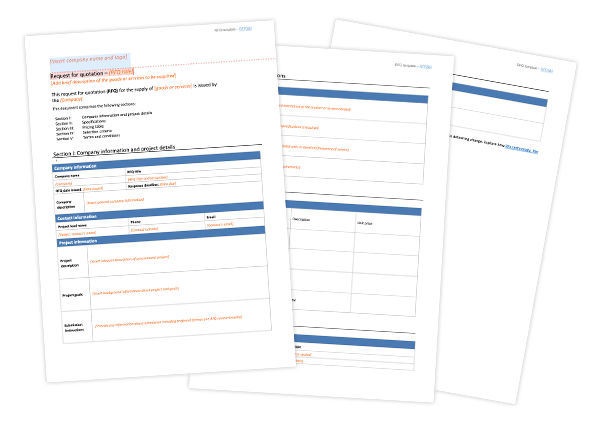
Request for qualifications — RFQ
Definition: Slightly less common than the request for quotation, a request for qualifications is also referred to as an RFQ. The questions in this type of RFX focus primarily on vendor expertise and experience. Consequently, the vendor response isn’t a proposal, but is instead referred to as a statement of qualifications or SOQ.
Use case: The request for qualifications is commonly used in construction and other large-scale purchases when expertise is paramount.
Helpful resources:
- The other RFQ: Guide to the request for qualifications
- Downloadable request for qualifications template in Word
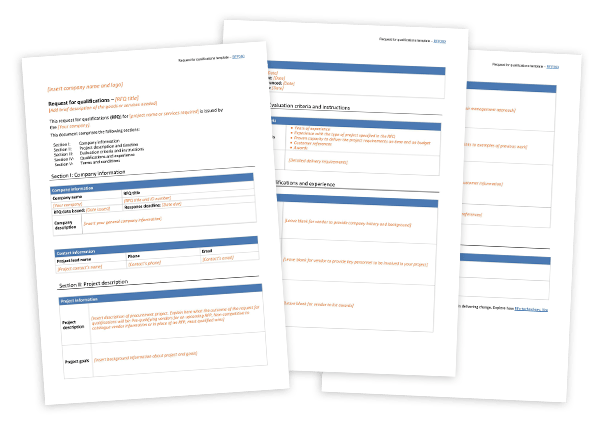
Request for proposal lite — RFP lite
Definition: A variation of the traditional RFP, the RFP lite, is an abbreviated request for proposal. Sometimes called a short-form RFP or simple RFP, this RFX may have as few as 10 questions, rather than the dozens often found in a traditional RFP.
Use case: Because it’s shorter, the RFP lite is fast, but it also must be very straightforward. Typically, the RFP lite is a good fit for low-risk, routine or recurring procurement projects. For instance, if you need to verify that your incumbent vendor is providing competitive services and rates.
Helpful resources:
- A simple RFP template: Benefits of the RFP lite
Electronic request for proposal— eRFP
Definition: eRFP stands for electronic request for proposal. Essentially, the eRFP is a digital version of an RFP.
Use case: Many procurement teams have embraced digital transformation and moved many processes, including sourcing, to digital platforms. For many, this means using a cloud-based RFP management system to improve processes increasing efficiency and collaboration for vendors and stakeholders alike.
Helpful resources:
- Strategic sourcing business case
- 22 of the best procurement technology tools
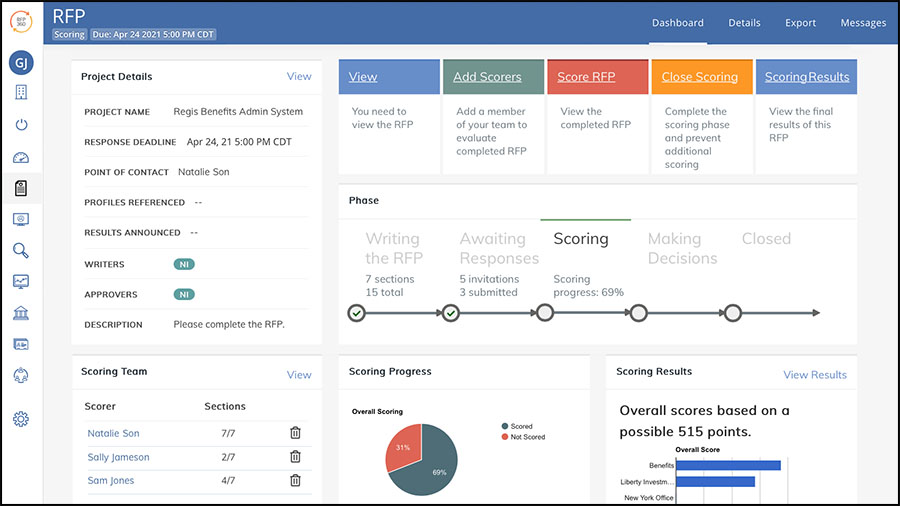
Request for tender — RFT
Definition: A request for tender, or RFT, is very similar to an RFP. Used outside of North America, a tender is similar to a proposal. The questionnaire asks vendors how they would meet the business’s unique needs.
Use case: Just like an RFP, the RFT is used as a part of vendor selection. Using this type of RFX means that a buyer has a need, is ready to select a vendor and make a purchase.
Helpful resources:
Request for bid — RFB
Definition: Abbreviated as RFB, a request for bid is another RFX that has a similar meaning to an RFP. A request for bid, sometimes called an invitation for bid (IFB) includes a list of questions intended to gather vendor information. One key distinction of the RFB is that it usually requires vendors to submit sealed bids that aren’t opened until the submission due date passes as defined in the RFP timeline.
Use case: A request for bid can be used for buying the same goods and services as an RFP. RFBs are more common outside of North America. Additionally, because of their sealed nature, they are preferred by procurement teams that are subject to regulations.
Helpful resources:
Request for offer — RFO
Definition: RFO, or a request for offer, is a questionnaire that invites vendors to submit a proposed solution to a buyer’s stated challenge. It provides slightly more leeway for vendor creativity than other RFX tools.
Use case: If you can provide clear guidance to vendors, but are open to other solutions, the request for offer is a good option. The RFO is a somewhat newer term that reflects procurement’s desire to move more toward collaborative processes.
Helpful resources:
Request for partner — RFP
Definition: An alternative to the traditional RFP, the new term, request for partner is another RFX type that encourages more transparent collaboration between buyers and sellers. While it outlines the background and context for the procurement process, it relies on communication rather than a one-sided collection and review of proposals.
Use case: The request for partner is best used for highly-strategic, long-term projects. This approach emphasizes the importance of building relationships.
Helpful resources:
- Unpacking the Request for Partner – The University of Tennessee
- Driving innovation with collaborative bidding – SIREAS
RFX process overview
Regardless of which RFX you choose to use, the basics steps involved remain mostly the same. Indeed, the RFX process involves only three steps: creation, administration and evaluation.
1. RFX creation
The first step in any RFX process is creating the document. This includes conducting initial research, planning your process and writing the RFX. These steps remain the same whether you use an RFI, RFQ or RFP.
Gather information
No matter what type of questionnaire you’re using, start by gathering important information about the need or project. What problem are you solving? Who needs to be involved in the process? What are the deliverables? How much can you spend? Clearly defining your goals, scope and budget at the beginning helps ensure a smooth process.
Plan your process
Once you’ve done the initial research and talked with stakeholders, it’s time to plan your RFX timeline. Assign dates to key milestones in the project to help keep your team on track. Additionally, having a clear timeline helps vendors engage with your project.
Write your RFX
Now, it’s time to create your vendor questionnaire. As you do this, try to consider the document from the vendor perspective. What information do they need to provide you with helpful answers? To start, include project background, current state, a problem statement and scope. Next, determine what RFX questions would be most helpful. This list of 101 sample RFP questions is a great place to start and each question can be used no matter which RFX you pick.
2. RFX administration
Select vendors and publish
Who are you sending your RFX to? It’s best to limit your RFX to three to six vendors that meet your needs. If you’re a private business, you can send your RFX directly to them. However, if you’re making a purchase on behalf of a government organization, you may need to publish the RFP publicly to meet regulatory guidelines.
Respond to questions
No matter what kind of RFX you issue, vendors will almost certainly have follow-up questions. Make sure your RFX timeline provides a question and answer period to ensure you get high-quality answers. Additionally, ensure fairness and transparency by providing the same answers to every participating vendor.
Send reminders
As your RFP deadline approaches, it’s wise to reach out to vendors who have not yet responded. When your due date is about a week away, send a follow up reminder to check in and encourage participation.
3. RFX evaluation
Score the proposals
Finally, we’ve arrived at the last step of the RFX process. Hopefully you have three or more qualified bids. Go through each response individually and score them using your evaluation criteria and weighted scoring. Leverage RFP automation capabilities in strategic sourcing software for this step if available.
Review results
Now that you’ve scored the vendor proposals, review the strengths and weaknesses of each. Use a vendor comparison matrix to see responses side by side and determine which option is the best for your purposes.
Select a vendor or determine next steps
If you’re ready to make a purchase, the last step is to select a winner. On the other hand, if you’re not quite ready to buy, use the information you’ve gathered to narrow your vendor selection to a shortlist or to direct additional planning.
Ultimately, the meaning of RFX depends on how you use it. But, it’s a helpful term to represent all of the different types of documents that the procurement team uses to manage the RFX process.
For more information about how to use various RFX tools and documents, check out our blog. Or, for templates, checklists and ebooks, explore our resources.
- RFP360 blog
- RFP360 resources



